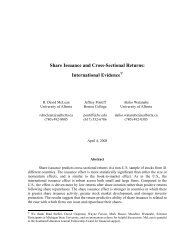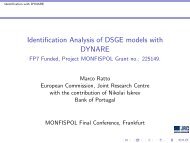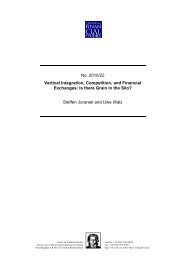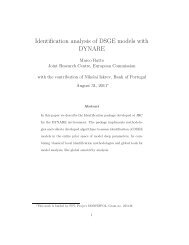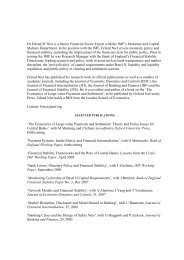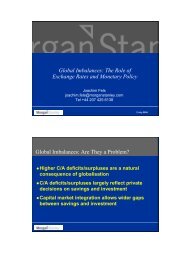Forecasting and Policy Making (Paper) - Center for Financial Studies
Forecasting and Policy Making (Paper) - Center for Financial Studies
Forecasting and Policy Making (Paper) - Center for Financial Studies
You also want an ePaper? Increase the reach of your titles
YUMPU automatically turns print PDFs into web optimized ePapers that Google loves.
it turns negative because real GDP declined <strong>and</strong> at the same time potential output increased. In<br />
2010 the output gap comes close to zero as real GDP grew again <strong>and</strong> potential output declined. The<br />
<strong>for</strong>ecast <strong>for</strong> the output gap is slightly above zero as real GDP is predicted to grow somewhat faster<br />
than potential GDP. In this model potential GDP <strong>and</strong> thus also the output gap have a clear structural<br />
interpretation. While in the previous small structural model potential GDP was modeled as a trend,<br />
potential output here is defined as the level of output <strong>and</strong> expenditure that would be realized in the<br />
absence of price <strong>and</strong> wage rigidities <strong>and</strong> price <strong>and</strong> wage mark-up shocks.<br />
Using a decomposition in historical shocks <strong>for</strong> <strong>for</strong>ecast interpretation<br />
To analyze which shocks played an important role during the financial crisis <strong>and</strong> recession, <strong>and</strong><br />
to investigate which have of them have a lasting impact over the current <strong>for</strong>ecast, we compute a<br />
historical decomposition. Using the moving average representation of the model solution, we eval-<br />
uate how much each type of shock contributes to a particular variable at each point in time over the<br />
sample period <strong>and</strong> over the <strong>for</strong>ecast period. The model contains seven shocks: risk premium shock,<br />
investment-specific technology shock, technology/supply shock, monetary policy shock <strong>and</strong> price <strong>and</strong><br />
wage mark-up shocks. Figure 13 displays the decomposition of historical annualized quarterly out-<br />
put growth <strong>and</strong> its <strong>for</strong>ecasts. The bars <strong>for</strong> each period summarize the contributions of all shocks to<br />
output growth, some of them positive some negative. The areas with different textures identify the<br />
size of the contribution of each type of shock.<br />
In addition to the shocks, the label of the chart refers to two more contributions to growth termed<br />
”starting values” <strong>and</strong> ”population growth”. The bars labeled starting values appear because data is<br />
not available <strong>for</strong> an infinite past history, <strong>and</strong> there<strong>for</strong>e shock realizations cannot be recovered from an<br />
infinite past. Thus, the ”starting values” bar indicates the impact of the initial conditions. The effect<br />
of initial conditions turns out to be negligible over the period shown in Figure 13.<br />
DSGE models are usually defined in per capita terms. However, policy makers are more interested<br />
in aggregate growth rates. There<strong>for</strong>e, the black solid-line indicates overall real GDP growth rather<br />
than per capita growth. Consequently, part of the GDP growth is due to population growth. This<br />
contribution is indicated by the ”population growth” bars. As population growth is not defined in<br />
the model, we simply assume <strong>for</strong> the <strong>for</strong>ecast that the population growth rate equals the average<br />
population growth rate in 2009 <strong>and</strong> 2010. The horizontal axis indicates the steady-state per capita<br />
growth rate. For long-run <strong>for</strong>ecasts the impact of the shocks will disappear <strong>and</strong> per capita growth will<br />
converge to this estimated steady state growth rate.<br />
The positive <strong>and</strong> negative contributions from shocks, population growth <strong>and</strong> starting values sum up<br />
to the actual output growth rate (black line) over the sample period <strong>and</strong> to the predicted output growth<br />
rate over the <strong>for</strong>ecast period. Interestingly, the deep recession of 2008 <strong>and</strong> 2009 is largely attributed<br />
to the combination of substantial (positive) risk premium shocks <strong>and</strong> negative investment shocks.<br />
The contribution of these two types of shocks is lumped in the left shaded area of the contribution<br />
bars. In other words, the recession, which was not predicted by the model, is explained as being due<br />
to a sequence of unexpectedly high risk premia realizations together with unexpected shortfalls of<br />
50



